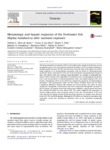Por favor, use este identificador para citar o enlazar este ítem:
http://www.alice.cnptia.embrapa.br/alice/handle/doc/982178Registro completo de metadatos
| Campo DC | Valor | Lengua/Idioma |
|---|---|---|
| dc.contributor.author | ASSIS, H. C. S. de | pt_BR |
| dc.contributor.author | SILVA, C. A. da | pt_BR |
| dc.contributor.author | OBA, E. T. | pt_BR |
| dc.contributor.author | PAMPLONA, J. H. | pt_BR |
| dc.contributor.author | MELA, M. | pt_BR |
| dc.contributor.author | DORIA, H. B. | pt_BR |
| dc.contributor.author | GUILOSKI, I. C. | pt_BR |
| dc.contributor.author | RAMSDORF, W. | pt_BR |
| dc.contributor.author | CESTARI, M. M. | pt_BR |
| dc.date.accessioned | 2014-03-13T11:11:11Z | pt_BR |
| dc.date.available | 2014-03-13T11:11:11Z | pt_BR |
| dc.date.created | 2014-03-13 | pt_BR |
| dc.date.issued | 2013 | pt_BR |
| dc.identifier.citation | Toxicon, Oxford, v. 66, p. 25-30, 2013. | pt_BR |
| dc.identifier.uri | http://www.alice.cnptia.embrapa.br/alice/handle/doc/982178 | pt_BR |
| dc.description | The bioaccumulation of saxitoxins (STX) in the trophic chain, mainly in freshwater, are not completely known. This work aimed to elucidate the effects of STX on Hoplias malabaricus through trophic bioassay. The fish were fed once every five days with Astyanax sp. before being subjected to an intraperitoneal inoculation with the lysate of Cylindrospermopsis raciborskii culture containing 97% STX and 3% by neosaxitoxin and gonyautoxin during 20 days. The animal?s liver was assessed using biomarkers as activities of superoxide dismutase (SOD), catalase (CAT), glutathione S-transferase (GST), and glutathione peroxidase (GPx), and concentrations of reduced glutathione (GSH) and lipoperoxidation (LPO) and protein carbonylation (PCO). In the blood was analyzed the genotoxic and hematological parameters. The hepatosomatic index and the relative condition factor did not show a significant difference between the exposed and control groups. The values of mean corpuscular hemoglobin concentration and mean corpuscular hemoglobin increased in the STX group. The hepatic tissue from both groups exhibited a typical pattern that have been already described for most teleost fish. The results suggested the generation of reactive oxygen species, with increased activity of GPx and concentrations of LPO and GSH; whereas the specific activity of SOD decreased. However, no changes were observed in the CAT, PCO, and DNA damage. Although the STX effects are known as neurotoxic, this cyanotoxin caused liver biochemical alterations that can be considered ecologically relevant. | pt_BR |
| dc.language.iso | eng | eng |
| dc.rights | openAccess | eng |
| dc.subject | Cyanotoxin | pt_BR |
| dc.subject | Genotoxicidade | pt_BR |
| dc.subject | Paralytic shellfish poison | pt_BR |
| dc.subject | Cianotoxina | pt_BR |
| dc.subject | Eutroficação | pt_BR |
| dc.title | Hematologic and hepatic responses of the freshwater fish Hoplias malabaricus after saxitoxin exposure. | pt_BR |
| dc.type | Artigo de periódico | pt_BR |
| dc.date.updated | 2017-03-20T11:11:11Z | pt_BR |
| dc.subject.thesagro | Peixe de água doce | pt_BR |
| dc.subject.nalthesaurus | genotoxicity | pt_BR |
| dc.subject.nalthesaurus | eutrophication | pt_BR |
| dc.subject.nalthesaurus | freshwater fish | pt_BR |
| riaa.ainfo.id | 982178 | pt_BR |
| riaa.ainfo.lastupdate | 2017-03-20 | pt_BR |
| dc.identifier.doi | 10.1016/j.toxicon.2013.01.012. | pt_BR |
| dc.contributor.institution | ELIANE TIE OBA YOSHIOKA, CPAF-AP. | pt_BR |
| Aparece en las colecciones: | Artigo em periódico indexado (CPAF-AP)  | |
Ficheros en este ítem:
| Fichero | Descripción | Tamaño | Formato | |
|---|---|---|---|---|
| CPAFAP2013Hematologicandhepatic.pdf | 499,82 kB | Adobe PDF |  Visualizar/Abrir |









